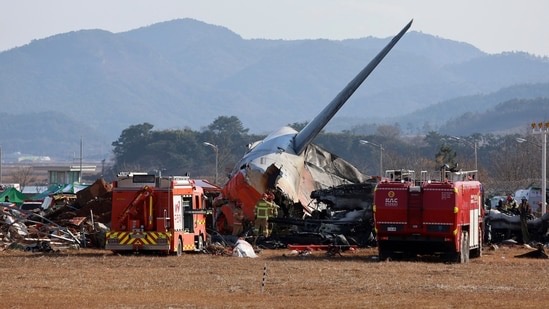A series of deadly plane crashes in December raised safety concerns in aviation. The worst incident involved a Jeju Air flight in South Korea, killing 177. A string of deadly plane crashes in December has left dozens dead and raised questions about safety protocols and equipment failures in the aviation industry. The most devastating incident occurred on Sunday when a Jeju Air passenger plane crashed at Muan Airport in South Korea. The plane, which was returning from Bangkok, reportedly lost control after its front landing gear failed to deploy, causing it to skid off the runway and slam into a concrete fence.
The collision resulted in a devastating fire that engulfed the aircraft. At least 177 people were confirmed dead. The plane had 181 people on board, and emergency responders are working to contain the fire, with 32 fire trucks and helicopters to the scene. Two survivors have been pulled from the wreckage, including a crew member and a passenger. The cause of the landing gear failure is still under investigation, and officials have expressed shock over the severity of the incident, which ranks as one of South Korea’s worst aviation disasters.
This is the first fatal accident in the history of Jeju Air, one of South Korea’s largest low-cost carriers, which was set up in 2005. On August 12, 2007, a Bombardier Q400 operated by Jeju Air carrying 74 passengers came off the runway due to strong winds at the southern Busan-Gimhae airport, resulting in a dozen injuries. South Korea’s aviation industry has a solid track record for safety, experts say.
Azerbaijan Airlines crash
On December 25, an Azerbaijan Airlines Embraer ERJ-190AR crashed near Aktau Airport in Kazakhstan, killing 38 people. The plane was flying from Baku to Grozny when it declared an emergency and was forced to divert due to technical issues and challenging weather conditions. After a series of failed landing attempts at its original destination, Grozny Airport, the plane ultimately collided with the ground near Aktau. 38 people were killed out of 67 fliers, and several others were hospitalised.
Preliminary reports suggest that the aircraft experienced fluctuating altitude and speed, possibly caused by mechanical or external interference. The Russian Federal Agency for Air Transport linked the crash to potential disruptions caused by nearby military operations, including Ukrainian drone attacks in the region. The crash also occurred during dense fog conditions, making the situation even more hazardous.
Brazil horror
Ten members of a family were killed on December 22 when a private plane crashed in the city of Gramado, located in southern Brazil. Brazilian businessman Luiz Claudio Galeazzi, who was piloting the aircraft, died in the crash along with his wife, three daughters, and other relatives, according to a statement from his company. The small plane is said to have struck a building’s chimney, a house, and a shop as it descended. Local authorities reported that 17 people on the ground were injured in the incident, including two who are in serious condition.
Papua New Guinea crash
A Britten-Norman BN-2B-26 Islander operated by North Coast Aviation crashed in Papua New Guinea on December 22, killing all five people on board. The plane was on a charter flight from Wasu Airport to Lae-Nadzab Airport. The wreckage was discovered the following day, with no survivors. The aircraft’s last known contact was just minutes before the crash, and a distress signal was received at 10:30 local time. A full investigation is underway.
Argentina fatal crash
A Bombardier BD-100-1A10 Challenger 300 crashed near San Fernando Airport in Argentina, killing both pilots. The plane was on a ferry flight from Punta del Este Airport to San Fernando Airport. It overshot the runway and collided with a perimeter fence and a tree, eventually catching fire. The aircraft’s left wing separated from the fuselage, and the pilots died in the blaze. The runway at San Fernando Airport was deemed insufficient for the aircraft, leading to an investigation into whether inadequate runway length contributed to the tragedy.
Hawaii plane crash
On December 17, a Cessna 208B Grand Caravan operated by Kamaka Air LLC crashed near Daniel K Inouye International Airport in Honolulu, Hawaii, killing both pilots. The plane was on an instructional flight. According to ATC communications, the aircraft appeared to lose control soon after liftoff, performing a sharp left bank before crashing into a building. Investigators are examining the cause of the accident, though it is believed to have occurred during a training flight.
These deadly accidents highlight ongoing concerns about aviation safety, from equipment failures to external factors such as weather conditions and military activity. As investigations continue, the aviation industry faces growing pressure to reassess safety protocols and improve aircraft maintenance standards to prevent further tragedies.



